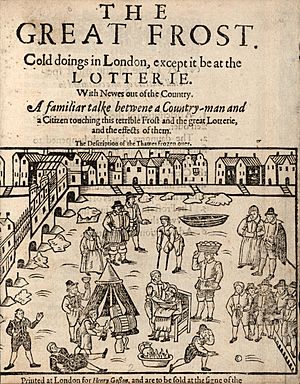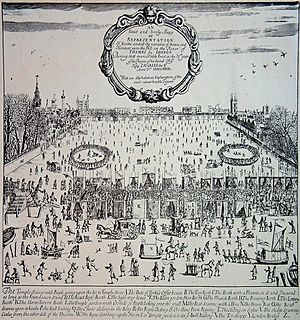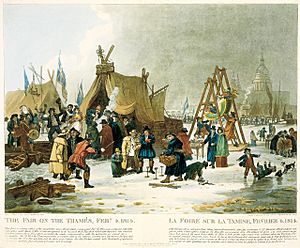River Thames frost fairs facts for kids
The River Thames frost fairs were amazing events that happened on the frozen River Thames in London, England. Imagine the river turning into a giant playground! These fairs took place during some very cold winters, mostly between the 1600s and early 1800s. This period was known as the Little Ice Age, when winters were much colder than they are today.
Back then, the Thames was wider and flowed slower. Also, the old London Bridge had many piers (supports) that blocked the water. This made it easier for the river to freeze solid. Even so, the river didn't freeze every winter. It happened about once every ten years. The last big freeze on the higher parts of the Thames was in 1962–63.
Frost fairs were quite rare, even during the coldest times. Some famous ones happened in 695, 1608, 1683-84, 1716, 1739–40, 1789, and 1814. Other countries, like the Netherlands, had similar winter events. Today, many places have winter festivals and carnivals that are a bit like these old frost fairs.
During the "Great Frost" of 1683–84, England had its coldest winter ever recorded. The Thames froze completely for two months! The ice in London was about 11 inches (28 cm) thick. This caused big problems for ships and harbours.
Contents
Why the Thames Froze Over
The River Thames froze more often a long time ago. One of the earliest records of it freezing is from AD 250. It was frozen for six weeks then! In 923, the river was so frozen that people used it for wheeled traffic to move goods for 13 weeks.
The time from the mid-1300s to the 1800s is called the Little Ice Age. Winters in Europe were much harsher. When the ice on the Thames was thick enough, Londoners would go onto the river. They used it for travel, trade, and fun. This fun eventually turned into big public festivals and fairs.
The Thames was wider and shallower in the Middle Ages. It didn't have the high banks it has today. Also, the old London Bridge had many closely packed piers. These piers had large wooden casings around them. Over time, these casings grew bigger, making the spaces under the bridge narrower. This made the water flow very fast. In winter, large chunks of ice would get stuck against these casings. They acted like a dam, blocking the river when the tide went out. This helped the river freeze.
Famous Frost Fairs
The First Known Fair: AD 695
The very first known time the River Thames froze enough for a fair was in AD 695. The river was frozen for six weeks. People set up small shops on the ice to sell their goods.
The First "Frost Fair": 1608
The year 1608 was the first time people actually called the event a "frost fair." There was lots to do! People enjoyed dancing, playing football, and nine-pin bowling. There was even gambling, though it wasn't officially allowed. You could find barbers, fruit sellers, and shoemakers. The shoemakers even had fires in their tents to keep warm!
The Great Frost Fair: 1683-84
The most famous frost fair happened in the winter of 1683–84. The river was a hub of activity! You could see football games, horse and coach races, and people ice skating. There were also puppet shows and sledding.
A printer named Croom sold special souvenir cards for sixpence. These cards had the customer's name, the date, and said they were printed on the Thames. He made a lot of money! Even King Charles II bought one.
But the cold wasn't just for fun. It was so cold that many animals and plants died. Fuel for fires became very expensive, and people had to help the poor stay warm. The air in London was also very smoky from all the coal fires, making it hard to breathe.
One person who saw the 1683–84 fair wrote about it: "On December 20, 1683, a very strong frost began. It lasted until February 6. The ponds were frozen at least 18 inches thick. The Thames was so frozen that a big street was built on it from the Temple to Southwark, with shops selling all sorts of things. Horse-drawn carriages drove there just like on regular streets. There were also bull-baiting and many shows. On February 6, the frost broke up. I saw a coach with six horses driven almost to London Bridge. But by three o'clock that day, the ice near Southwark was gone, and boats could row. The next day, all the ice was gone. On Candlemas Day, I walked my horse over the ice from Westminster to Lambeth. When I came back, I led him from Lambeth across the middle of the Thames to Whitefriars' stairs. That day, an ox was roasted whole near Whitehall. King Charles and the Queen ate some of it."
These frost fairs were often short. The weather could change quickly, and the ice would start melting. Sometimes, fast thaws caused accidents. In January 1789, melting ice pulled a ship that was tied to a building by the river. The building collapsed, and five people died.
18th Century Fairs
There were also frost fairs in 1715-16, 1739–40, and 1789.
The Last Frost Fair: 1814
The very last frost fair happened in 1814. It started on February 1 and lasted four days, between Blackfriars Bridge and London Bridge. An elephant was even led across the river near Blackfriars! It had been freezing every night from December 27, 1813, to February 7, 1814. Many Londoners went onto the frozen Thames.
All kinds of traders set up stalls to sell their goods. Peddlers walked through the crowds. You could buy food and drinks like beef, coffee, gin, gingerbread, hot apples, roast mutton, hot chocolate, and tea. People also enjoyed dancing and nine-pin bowling.
When the ice started to break up on February 5, several people drowned.
About a dozen printing presses were also on the ice, making special poems to remember the fair. A printer named George Davis even printed a whole 124-page book on the frozen Thames! It was called Frostiana. The book told the story of the frost, funny sayings, and other weather facts.
This was the last frost fair. The weather started to get warmer. Also, the old London Bridge was taken down in 1831. A new bridge with wider arches was built, which let the tide flow more freely. The river banks were also built up. All these changes made it much harder for the river to freeze over.
Other Frozen Thames Events
16th Century Freezes
The Thames froze several times in the 1500s. King Henry VIII traveled from central London to Greenwich by sleigh on the river in 1536. Queen Elizabeth I often went onto the ice in 1564 to practice archery. Small boys even played football on the ice!
Walking from Fulham to Putney: 1788-1789
In January 1789, the river was completely frozen. People could walk across it from Fulham to Putney. There were even fairground booths, puppet shows, and roundabouts set up on the ice!
Remembering the Frost Fairs
Southwark Engraving
In a walking tunnel under the southern end of Southwark Bridge, there is a special engraving by artist Richard Kindersley. It's made of five grey stone slabs and shows the frost fair.
The carving has words that say:
Behold the Liquid Thames frozen o’re,
That lately Ships of mighty Burthen bore
The Watermen for want of Rowing Boats
Make use of Booths to get their Pence & Groats
Here you may see beef roasted on the spit
And for your money you may taste a bit
There you may print your name, tho cannot write
Cause num'd with cold: tis done with great delight
And lay it by that ages yet to come
May see what things upon the ice were done
These words are based on old flyers that were printed right on the Thames during the frost fairs!






